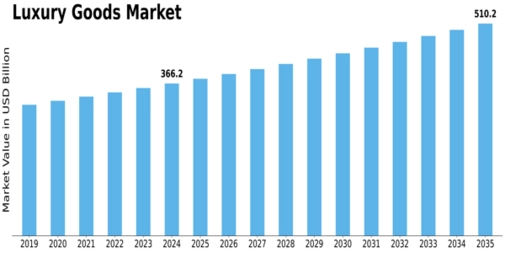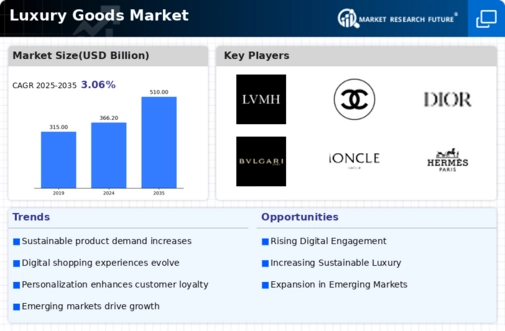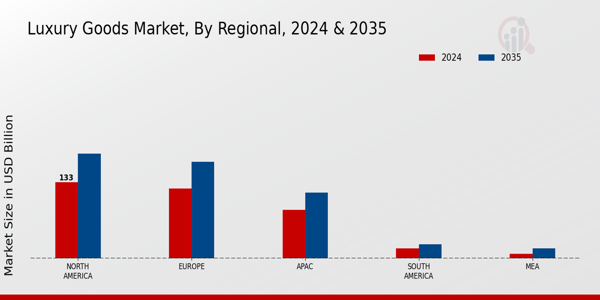-
EXECUTIVE SUMMARY
-
Market Overview
-
Market Segmentation
-
Competitive Landscape
-
Future Outlook
-
MARKET INTRODUCTION
-
Scope of the study
- Research Objective
- Limitations
-
RESEARCH METHODOLOGY
-
Data Mining
-
Secondary Research
-
Primary Research
- Breakdown of Primary Respondents
-
Forecasting Model
-
Market Size Estimation
- Top-Down Approach
-
Data Triangulation
-
MARKET DYNAMICS
-
Overview
-
Drivers
-
Restraints
-
Opportunities
-
MARKET FACTOR ANALYSIS
-
Porter's Five Forces Analysis
- Bargaining Power of Suppliers
- Bargaining Power of Buyers
- Threat of New Entrants
- Threat of Substitutes
- Intensity of Rivalry
- Market Impact Analysis
- Regional
- Opportunity and Threat Analysis
-
LUXURY
-
Fashion Accessories
-
Watches
-
Leather Goods
-
Cosmetics
-
LUXURY
-
Online Retail
-
Specialty Stores
-
Direct Sales
-
Millennials
-
Generation
-
Baby Boomers
-
LUXURY GOODS MARKET, BY PRICE RANGE (USD BILLION)
-
Affordable Luxury
-
Mid-Range Luxury
-
High-End
-
LUXURY GOODS MARKET, BY REGIONAL (USD BILLION)
-
North
- US
- Canada
-
Europe
- Germany
- France
- Russia
- Italy
- Rest of Europe
-
APAC
- China
- Japan
- South Korea
- Malaysia
- Indonesia
- Rest of APAC
-
South America
- Mexico
- Argentina
- Rest of South America
-
MEA
- GCC Countries
- South Africa
-
COMPETITIVE LANDSCAPE
-
Overview
-
Competitive
-
Market share Analysis
-
Major Growth Strategy in the Luxury
-
Competitive Benchmarking
-
Leading Players in Terms
-
Key developments and growth
- New Product Launch/Service Deployment
- Joint Ventures
-
Major Players Financial
- Sales and Operating Income
- Major Players R&D
-
COMPANY PROFILES
-
LVMH
- Products Offered
- Key Developments
- Key Strategies
-
Burberry
- Products Offered
- Key Developments
- Key Strategies
-
Chanel
- Products Offered
- Key Developments
- Key Strategies
-
Dior
- Products Offered
- Key Developments
- Key Strategies
-
Bulgari
- Products Offered
- Key Developments
- Key Strategies
-
Moncler
- Products Offered
- Key Developments
- Key Strategies
-
Omegawatch
- Products Offered
- Key Developments
- Key Strategies
-
Hermes
- Products Offered
- Key Developments
- Key Strategies
-
Prada
- Products Offered
- Key Developments
- Key Strategies
-
Coach
- Products Offered
- Key Developments
- Key Strategies
-
Tiffany & Co
- Products Offered
- Key Developments
- Key Strategies
-
Loro Piana
- Products Offered
- Key Developments
- Key Strategies
-
Kering
- Products Offered
- Key Developments
- Key Strategies
-
Ferragamo
- Products Offered
- Key Developments
- Key Strategies
-
Richemont
- Products Offered
- Key Developments
- Key Strategies
-
APPENDIX
-
References
-
Related Reports
-
LIST OF ASSUMPTIONS
-
NORTH AMERICA LUXURY GOODS MARKET SIZE ESTIMATES & FORECAST,
-
NORTH AMERICA LUXURY
-
NORTH AMERICA LUXURY GOODS MARKET SIZE ESTIMATES &
-
NORTH AMERICA LUXURY GOODS MARKET SIZE
-
US LUXURY GOODS MARKET SIZE ESTIMATES & FORECAST,
-
US LUXURY GOODS MARKET
-
US LUXURY GOODS MARKET SIZE ESTIMATES & FORECAST, BY PRICE
-
US LUXURY GOODS MARKET SIZE ESTIMATES
-
CANADA LUXURY GOODS
-
CANADA LUXURY GOODS MARKET SIZE ESTIMATES & FORECAST, BY
-
CANADA LUXURY GOODS
-
CANADA LUXURY GOODS MARKET SIZE ESTIMATES & FORECAST, BY
-
CANADA LUXURY GOODS MARKET
-
EUROPE LUXURY GOODS MARKET SIZE ESTIMATES & FORECAST, BY PRODUCT TYPE, 2019-2035
-
EUROPE LUXURY GOODS MARKET SIZE ESTIMATES & FORECAST,
-
EUROPE LUXURY GOODS
-
EUROPE LUXURY GOODS MARKET SIZE ESTIMATES & FORECAST, BY
-
EUROPE LUXURY GOODS MARKET
-
GERMANY LUXURY GOODS MARKET SIZE ESTIMATES & FORECAST, BY PRODUCT TYPE,
-
GERMANY LUXURY GOODS MARKET SIZE ESTIMATES
-
GERMANY LUXURY GOODS MARKET SIZE ESTIMATES
-
GERMANY LUXURY GOODS
-
UK LUXURY GOODS MARKET SIZE ESTIMATES & FORECAST, BY PRODUCT TYPE, 2019-2035
-
UK LUXURY GOODS MARKET SIZE ESTIMATES & FORECAST,
-
UK LUXURY GOODS MARKET
-
UK LUXURY GOODS MARKET SIZE ESTIMATES & FORECAST, BY PRICE
-
UK LUXURY GOODS MARKET SIZE ESTIMATES
-
FRANCE LUXURY GOODS
-
FRANCE LUXURY GOODS MARKET SIZE ESTIMATES & FORECAST, BY
-
FRANCE LUXURY GOODS
-
FRANCE LUXURY GOODS MARKET SIZE ESTIMATES & FORECAST, BY
-
FRANCE LUXURY GOODS MARKET
-
RUSSIA LUXURY GOODS MARKET SIZE ESTIMATES & FORECAST, BY PRODUCT TYPE, 2019-2035
-
RUSSIA LUXURY GOODS MARKET SIZE ESTIMATES & FORECAST,
-
RUSSIA LUXURY GOODS
-
RUSSIA LUXURY GOODS MARKET SIZE ESTIMATES & FORECAST, BY
-
RUSSIA LUXURY GOODS MARKET
-
ITALY LUXURY GOODS MARKET SIZE ESTIMATES & FORECAST, BY PRODUCT TYPE, 2019-2035
-
ITALY LUXURY GOODS MARKET SIZE ESTIMATES & FORECAST,
-
ITALY LUXURY GOODS
-
ITALY LUXURY GOODS MARKET SIZE ESTIMATES & FORECAST, BY
-
ITALY LUXURY GOODS MARKET
-
SPAIN LUXURY GOODS MARKET SIZE ESTIMATES & FORECAST, BY PRODUCT TYPE, 2019-2035
-
SPAIN LUXURY GOODS MARKET SIZE ESTIMATES & FORECAST,
-
SPAIN LUXURY GOODS
-
SPAIN LUXURY GOODS MARKET SIZE ESTIMATES & FORECAST, BY
-
SPAIN LUXURY GOODS MARKET
-
REST OF EUROPE LUXURY GOODS MARKET SIZE ESTIMATES & FORECAST, BY PRODUCT
-
REST OF EUROPE LUXURY GOODS MARKET SIZE
-
REST OF EUROPE LUXURY GOODS MARKET SIZE ESTIMATES & FORECAST, BY CONSUMER
-
REST OF EUROPE LUXURY GOODS
-
REST OF EUROPE LUXURY GOODS MARKET SIZE ESTIMATES & FORECAST, BY REGIONAL,
-
APAC LUXURY GOODS MARKET SIZE ESTIMATES
-
APAC LUXURY GOODS MARKET
-
APAC LUXURY GOODS MARKET SIZE ESTIMATES & FORECAST, BY CONSUMER
-
APAC LUXURY GOODS MARKET SIZE
-
CHINA LUXURY GOODS MARKET SIZE ESTIMATES & FORECAST,
-
CHINA LUXURY GOODS
-
CHINA LUXURY GOODS MARKET SIZE ESTIMATES & FORECAST, BY
-
CHINA LUXURY GOODS
-
CHINA LUXURY GOODS MARKET SIZE ESTIMATES & FORECAST, BY REGIONAL, 2019-2035
-
INDIA LUXURY GOODS MARKET SIZE ESTIMATES & FORECAST,
-
INDIA LUXURY GOODS
-
INDIA LUXURY GOODS MARKET SIZE ESTIMATES & FORECAST, BY
-
INDIA LUXURY GOODS
-
INDIA LUXURY GOODS MARKET SIZE ESTIMATES & FORECAST, BY REGIONAL, 2019-2035
-
JAPAN LUXURY GOODS MARKET SIZE ESTIMATES & FORECAST,
-
JAPAN LUXURY GOODS
-
JAPAN LUXURY GOODS MARKET SIZE ESTIMATES & FORECAST, BY
-
JAPAN LUXURY GOODS
-
JAPAN LUXURY GOODS MARKET SIZE ESTIMATES & FORECAST, BY REGIONAL, 2019-2035
-
SOUTH KOREA LUXURY GOODS MARKET SIZE ESTIMATES &
-
SOUTH KOREA LUXURY
-
SOUTH KOREA LUXURY GOODS MARKET SIZE ESTIMATES &
-
SOUTH KOREA LUXURY GOODS MARKET SIZE ESTIMATES &
-
MALAYSIA LUXURY GOODS
-
MALAYSIA LUXURY GOODS MARKET SIZE ESTIMATES & FORECAST,
-
MALAYSIA LUXURY GOODS
-
MALAYSIA LUXURY GOODS MARKET SIZE ESTIMATES & FORECAST,
-
MALAYSIA LUXURY GOODS
-
THAILAND LUXURY GOODS MARKET SIZE ESTIMATES & FORECAST, BY PRODUCT TYPE,
-
THAILAND LUXURY GOODS MARKET SIZE ESTIMATES
-
THAILAND LUXURY GOODS MARKET SIZE ESTIMATES
-
THAILAND LUXURY GOODS
-
INDONESIA LUXURY GOODS MARKET SIZE ESTIMATES & FORECAST, BY PRODUCT TYPE,
-
INDONESIA LUXURY GOODS MARKET SIZE ESTIMATES
-
INDONESIA LUXURY GOODS MARKET SIZE ESTIMATES
-
INDONESIA LUXURY GOODS
-
REST OF APAC LUXURY GOODS MARKET SIZE ESTIMATES & FORECAST, BY PRODUCT TYPE,
-
REST OF APAC LUXURY GOODS MARKET SIZE
-
REST OF APAC LUXURY GOODS MARKET SIZE ESTIMATES & FORECAST, BY CONSUMER
-
REST OF APAC LUXURY GOODS
-
REST OF APAC LUXURY GOODS MARKET SIZE ESTIMATES & FORECAST, BY REGIONAL,
-
SOUTH AMERICA LUXURY GOODS MARKET SIZE
-
SOUTH AMERICA LUXURY GOODS
-
SOUTH AMERICA LUXURY GOODS MARKET SIZE ESTIMATES & FORECAST,
-
SOUTH AMERICA LUXURY
-
BRAZIL LUXURY GOODS MARKET SIZE ESTIMATES & FORECAST, BY
-
BRAZIL LUXURY GOODS MARKET
-
BRAZIL LUXURY GOODS MARKET SIZE ESTIMATES & FORECAST, BY
-
BRAZIL LUXURY GOODS
-
BRAZIL LUXURY GOODS MARKET SIZE ESTIMATES & FORECAST, BY REGIONAL, 2019-2035
-
MEXICO LUXURY GOODS MARKET SIZE ESTIMATES &
-
MEXICO LUXURY GOODS
-
MEXICO LUXURY GOODS MARKET SIZE ESTIMATES & FORECAST, BY
-
MEXICO LUXURY GOODS
-
MEXICO LUXURY GOODS MARKET SIZE ESTIMATES & FORECAST, BY REGIONAL, 2019-2035
-
ARGENTINA LUXURY GOODS MARKET SIZE ESTIMATES &
-
ARGENTINA LUXURY GOODS
-
ARGENTINA LUXURY GOODS MARKET SIZE ESTIMATES & FORECAST,
-
ARGENTINA LUXURY GOODS
-
ARGENTINA LUXURY GOODS MARKET SIZE ESTIMATES & FORECAST, BY REGIONAL, 2019-2035
-
REST OF SOUTH AMERICA LUXURY GOODS MARKET SIZE ESTIMATES
-
REST OF SOUTH AMERICA
-
REST OF SOUTH AMERICA LUXURY GOODS MARKET SIZE ESTIMATES
-
REST OF SOUTH AMERICA LUXURY GOODS MARKET
-
MEA LUXURY GOODS MARKET SIZE ESTIMATES & FORECAST, BY PRODUCT TYPE, 2019-2035
-
MEA LUXURY GOODS MARKET SIZE ESTIMATES & FORECAST,
-
MEA LUXURY GOODS MARKET
-
MEA LUXURY GOODS MARKET SIZE ESTIMATES & FORECAST, BY PRICE
-
MEA LUXURY GOODS MARKET SIZE ESTIMATES
-
GCC COUNTRIES LUXURY
-
GCC COUNTRIES LUXURY GOODS MARKET SIZE ESTIMATES & FORECAST,
-
GCC COUNTRIES LUXURY
-
GCC COUNTRIES LUXURY GOODS MARKET SIZE ESTIMATES
-
GCC COUNTRIES LUXURY
-
SOUTH AFRICA LUXURY GOODS MARKET SIZE ESTIMATES & FORECAST,
-
SOUTH AFRICA LUXURY
-
SOUTH AFRICA LUXURY GOODS MARKET SIZE ESTIMATES
-
SOUTH AFRICA LUXURY GOODS MARKET SIZE
-
REST OF MEA LUXURY GOODS MARKET SIZE
-
REST OF MEA LUXURY GOODS MARKET SIZE ESTIMATES & FORECAST, BY CONSUMER
-
REST OF MEA LUXURY GOODS
-
REST OF MEA LUXURY GOODS MARKET SIZE ESTIMATES & FORECAST, BY REGIONAL,
-
PRODUCT LAUNCH/PRODUCT DEVELOPMENT/APPROVAL
-
ACQUISITION/PARTNERSHIP
-
MARKET SYNOPSIS
-
NORTH AMERICA LUXURY
-
US LUXURY GOODS MARKET ANALYSIS BY PRODUCT
-
US LUXURY GOODS MARKET ANALYSIS BY DISTRIBUTION CHANNEL
-
US LUXURY GOODS MARKET ANALYSIS BY CONSUMER DEMOGRAPHICS
-
US LUXURY GOODS MARKET
-
US LUXURY GOODS MARKET ANALYSIS BY REGIONAL
-
CANADA LUXURY GOODS MARKET ANALYSIS BY PRODUCT TYPE
-
CANADA LUXURY GOODS MARKET ANALYSIS BY DISTRIBUTION CHANNEL
-
CANADA LUXURY GOODS
-
EUROPE LUXURY GOODS MARKET ANALYSIS
-
GERMANY LUXURY GOODS MARKET ANALYSIS BY PRODUCT TYPE
-
GERMANY LUXURY GOODS MARKET ANALYSIS BY DISTRIBUTION CHANNEL
-
GERMANY LUXURY GOODS
-
UK LUXURY GOODS MARKET ANALYSIS BY PRODUCT
-
UK LUXURY GOODS MARKET ANALYSIS BY DISTRIBUTION CHANNEL
-
UK LUXURY GOODS MARKET ANALYSIS BY CONSUMER DEMOGRAPHICS
-
UK LUXURY GOODS MARKET
-
FRANCE LUXURY GOODS MARKET ANALYSIS BY PRODUCT TYPE
-
FRANCE LUXURY GOODS MARKET ANALYSIS BY DISTRIBUTION CHANNEL
-
FRANCE LUXURY GOODS MARKET ANALYSIS BY CONSUMER DEMOGRAPHICS
-
FRANCE LUXURY GOODS MARKET ANALYSIS BY PRICE RANGE
-
FRANCE LUXURY GOODS MARKET ANALYSIS BY REGIONAL
-
RUSSIA LUXURY GOODS
-
RUSSIA LUXURY GOODS MARKET ANALYSIS
-
RUSSIA LUXURY GOODS MARKET ANALYSIS
-
RUSSIA LUXURY GOODS MARKET ANALYSIS
-
RUSSIA LUXURY GOODS MARKET ANALYSIS BY REGIONAL
-
ITALY LUXURY GOODS MARKET ANALYSIS BY PRODUCT TYPE
-
ITALY LUXURY GOODS MARKET ANALYSIS BY DISTRIBUTION CHANNEL
-
ITALY LUXURY GOODS
-
ITALY LUXURY GOODS MARKET ANALYSIS BY
-
SPAIN LUXURY GOODS MARKET ANALYSIS BY PRODUCT TYPE
-
SPAIN LUXURY GOODS MARKET ANALYSIS BY DISTRIBUTION CHANNEL
-
SPAIN LUXURY GOODS
-
SPAIN LUXURY GOODS MARKET ANALYSIS BY
-
REST OF EUROPE LUXURY GOODS MARKET ANALYSIS BY PRODUCT TYPE
-
REST OF EUROPE LUXURY GOODS MARKET ANALYSIS BY DISTRIBUTION
-
REST OF EUROPE LUXURY GOODS MARKET ANALYSIS BY CONSUMER DEMOGRAPHICS
-
REST OF EUROPE LUXURY GOODS MARKET ANALYSIS BY PRICE RANGE
-
REST OF EUROPE LUXURY GOODS MARKET ANALYSIS BY REGIONAL
-
APAC LUXURY GOODS MARKET ANALYSIS
-
CHINA LUXURY GOODS MARKET
-
CHINA LUXURY GOODS MARKET ANALYSIS BY
-
CHINA LUXURY GOODS MARKET ANALYSIS BY CONSUMER DEMOGRAPHICS
-
CHINA LUXURY GOODS MARKET ANALYSIS BY PRICE RANGE
-
CHINA LUXURY GOODS MARKET ANALYSIS BY REGIONAL
-
INDIA LUXURY GOODS
-
INDIA LUXURY GOODS MARKET ANALYSIS BY
-
INDIA LUXURY GOODS MARKET ANALYSIS BY CONSUMER DEMOGRAPHICS
-
INDIA LUXURY GOODS MARKET ANALYSIS BY PRICE RANGE
-
INDIA LUXURY GOODS MARKET ANALYSIS BY REGIONAL
-
JAPAN LUXURY GOODS
-
JAPAN LUXURY GOODS MARKET ANALYSIS BY
-
JAPAN LUXURY GOODS MARKET ANALYSIS BY CONSUMER DEMOGRAPHICS
-
JAPAN LUXURY GOODS MARKET ANALYSIS BY PRICE RANGE
-
JAPAN LUXURY GOODS MARKET ANALYSIS BY REGIONAL
-
SOUTH KOREA LUXURY
-
SOUTH KOREA LUXURY GOODS
-
SOUTH KOREA LUXURY
-
SOUTH KOREA LUXURY
-
SOUTH KOREA LUXURY GOODS
-
MALAYSIA LUXURY GOODS MARKET ANALYSIS
-
MALAYSIA LUXURY GOODS MARKET ANALYSIS BY DISTRIBUTION
-
MALAYSIA LUXURY GOODS MARKET ANALYSIS BY CONSUMER DEMOGRAPHICS
-
MALAYSIA LUXURY GOODS MARKET ANALYSIS BY PRICE RANGE
-
MALAYSIA LUXURY GOODS MARKET ANALYSIS BY REGIONAL
-
THAILAND LUXURY GOODS
-
THAILAND LUXURY GOODS MARKET ANALYSIS
-
THAILAND LUXURY GOODS MARKET ANALYSIS
-
THAILAND LUXURY GOODS MARKET ANALYSIS
-
THAILAND LUXURY GOODS MARKET ANALYSIS BY REGIONAL
-
INDONESIA LUXURY GOODS MARKET ANALYSIS BY PRODUCT TYPE
-
INDONESIA LUXURY GOODS MARKET ANALYSIS BY DISTRIBUTION CHANNEL
-
INDONESIA LUXURY GOODS
-
REST OF APAC LUXURY GOODS MARKET ANALYSIS
-
REST OF APAC LUXURY GOODS MARKET ANALYSIS BY DISTRIBUTION
-
REST OF APAC LUXURY GOODS MARKET ANALYSIS BY CONSUMER DEMOGRAPHICS
-
REST OF APAC LUXURY GOODS MARKET ANALYSIS BY PRICE RANGE
-
REST OF APAC LUXURY GOODS MARKET ANALYSIS BY REGIONAL
-
SOUTH AMERICA LUXURY
-
BRAZIL LUXURY GOODS MARKET ANALYSIS
-
BRAZIL LUXURY GOODS MARKET ANALYSIS BY DISTRIBUTION
-
BRAZIL LUXURY GOODS MARKET ANALYSIS BY CONSUMER DEMOGRAPHICS
-
BRAZIL LUXURY GOODS MARKET ANALYSIS BY PRICE RANGE
-
BRAZIL LUXURY GOODS MARKET ANALYSIS BY REGIONAL
-
MEXICO LUXURY GOODS
-
MEXICO LUXURY GOODS MARKET ANALYSIS
-
MEXICO LUXURY GOODS MARKET ANALYSIS
-
MEXICO LUXURY GOODS MARKET ANALYSIS
-
MEXICO LUXURY GOODS MARKET ANALYSIS BY REGIONAL
-
ARGENTINA LUXURY GOODS MARKET ANALYSIS BY PRODUCT TYPE
-
ARGENTINA LUXURY GOODS MARKET ANALYSIS BY DISTRIBUTION CHANNEL
-
ARGENTINA LUXURY
-
REST OF SOUTH AMERICA LUXURY
-
REST OF SOUTH AMERICA LUXURY
-
REST OF SOUTH AMERICA
-
REST OF SOUTH AMERICA
-
REST OF SOUTH AMERICA
-
MEA LUXURY GOODS
-
GCC COUNTRIES LUXURY GOODS MARKET ANALYSIS BY PRODUCT
-
GCC COUNTRIES LUXURY GOODS MARKET ANALYSIS BY DISTRIBUTION
-
GCC COUNTRIES LUXURY GOODS MARKET ANALYSIS BY CONSUMER DEMOGRAPHICS
-
GCC COUNTRIES LUXURY GOODS MARKET ANALYSIS BY PRICE RANGE
-
GCC COUNTRIES LUXURY GOODS MARKET ANALYSIS BY REGIONAL
-
SOUTH AFRICA LUXURY GOODS MARKET ANALYSIS BY PRODUCT TYPE
-
SOUTH AFRICA LUXURY
-
REST OF MEA LUXURY GOODS
-
REST OF MEA LUXURY GOODS MARKET ANALYSIS
-
REST OF MEA LUXURY GOODS MARKET ANALYSIS
-
REST OF MEA LUXURY GOODS MARKET ANALYSIS
-
REST OF MEA LUXURY GOODS MARKET ANALYSIS BY REGIONAL
-
KEY BUYING CRITERIA OF LUXURY GOODS MARKET
-
DRO ANALYSIS OF LUXURY GOODS MARKET
-
DRIVERS IMPACT ANALYSIS: LUXURY GOODS MARKET
-
SUPPLY / VALUE CHAIN:
-
LUXURY GOODS MARKET, BY PRODUCT TYPE, 2025 (% SHARE)
-
LUXURY GOODS MARKET, BY PRODUCT TYPE, 2019 TO 2035 (USD Billions)
-
LUXURY GOODS MARKET, BY DISTRIBUTION CHANNEL, 2025 (% SHARE)
-
LUXURY GOODS MARKET, BY DISTRIBUTION CHANNEL, 2019 TO 2035
-
LUXURY GOODS MARKET, BY CONSUMER DEMOGRAPHICS,
-
(% SHARE)
-
LUXURY GOODS MARKET, BY CONSUMER DEMOGRAPHICS,
-
TO 2035 (USD Billions)
-
LUXURY GOODS MARKET, BY PRICE RANGE,
-
(% SHARE)
-
LUXURY GOODS MARKET, BY PRICE RANGE, 2019 TO 2035
-
LUXURY GOODS MARKET, BY REGIONAL, 2025 (% SHARE)
-
LUXURY GOODS MARKET, BY REGIONAL, 2019 TO 2035 (USD Billions)
-
BENCHMARKING OF MAJOR COMPETITORS

















Leave a Comment